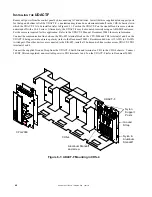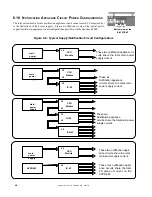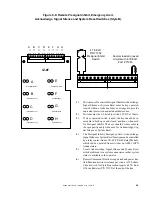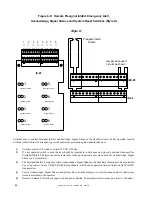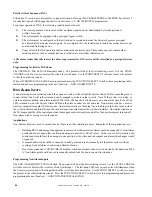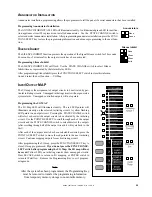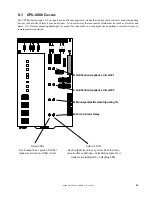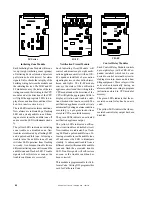
S2000 15017 Rev H 10/08/96 P/N 15017:H
54
Building HVAC and energy management sensors such as thermostats or timers could be connected to Non-Alarm
points and used to open/close ventilation dampers connected to CR-4F relays. In the event of a fire situation, the
control panel could force the dampers in one position or the other, and subsequent non alarm state changes would
be ignored.
A manual drill switch could be connected to an IZ point and used to manually test the alarm system without
causing a System Alarm or activating a Remote Station.
Door locks connected to CR-4F/CRE-4F modules could be unlocked when a fire is detected by the Sensiscan 2000.
A Non-Alarm point could be used to manually unlock/lock the doors in non-fire situations.
Programming Non-Alarm Inputs
The NON ALARM INPUTS LED will flash. The pointer will be at the first initiating circuit. Use the STATE CHANGE
switch to select or deselect the circuit as a Non Alarm Input. The left-hand LED (red) on each point will illuminate when
the circuit is selected, and will extinguish when the circuit has been deselected. Use the POINT SELECT switches to move
the pointer to the other initiating circuits. Press the FUNCTION SELECT switch to store this programming and proceed to
programming the next function ANNUNCIATOR INSTALLATION.
Positive Alarm Sequence (PAS)
PAS adds a 15 second, post-alarm delay to signal activation. Pressing the ACKNOWLEDGE or SILENCE key before 15
seconds has expired will change the timer to its full value (1, 2, OR 3 MINUTES) programmed.
For proper operation of PAS, the following conditions must be met:
1)
The control panel must be located so that an alarm signal can be acknowledged by trained personnel
within 15 seconds.
2)
The system must be equipped with a presignal bypass switch.
3)
The system must be configured so that activation of a second automatic fire detector bypasses presignal
and immediately activates alarm signals. To accomplish this, the installer must install one smoke detector per
conventional initiating device.
4)
Zones selected for PAS operation shall contain smoke detectors only. These zones may not contain other
initiating devices such as manual stations, heat detectors, waterflow indicators, etc.
A fire alarm system that fails to meet the above requirements for PAS service will be classified as a presignal system
only.
Programming Verified or PAS Zones
The VERIFIED / PAS LED will illuminate steady. The pointer will be at the first initiating circuit. Use the STATE
CHANGE switch to select or deselect the circuit for verification. Use the POINT SELECT switches to move the pointer
to the other initiating circuits.
When all VERIFIED / PAS ZONES are programmed press the FUNCTION SELECT switch to store programing infor-
mation and advance programming to the next function NON ALARM INPUTS.
N
ON
A
LARM
I
NPUTS
A non-alarm input is an initiating circuit that, upon activation, will not light the System Alarm LED or cause the piezo to
sound, will not latch, will self-restore and can be mapped to activate output circuits. Note: If the system is in alarm, or
enters an alarm condition, non-alarm inputs WILL latch. When a short circuit occurs on a non-alarm circuit, the IZ red
LED is turned on, but the System Alarm LED and the piezo sounder are not activated. Non-alarm points have a lower
priority compared to regular IZ alarm zones. Non-alarm circuits are "tracking" (non-latching) in that they turn on when
the circuit is shorted and turn off when the circuit returns to normal (unless the system is in alarm). Non-alarm circuits use
the I/O map capability of the control panel and the mapped controls simply turn on/off as the non-alarm point turns on/off.
Non-alarm circuits are supervised for opens.
Applications
Non-Alarm circuits are used to monitor devices that are not fire initiating sensors. Examples of these applications are:

